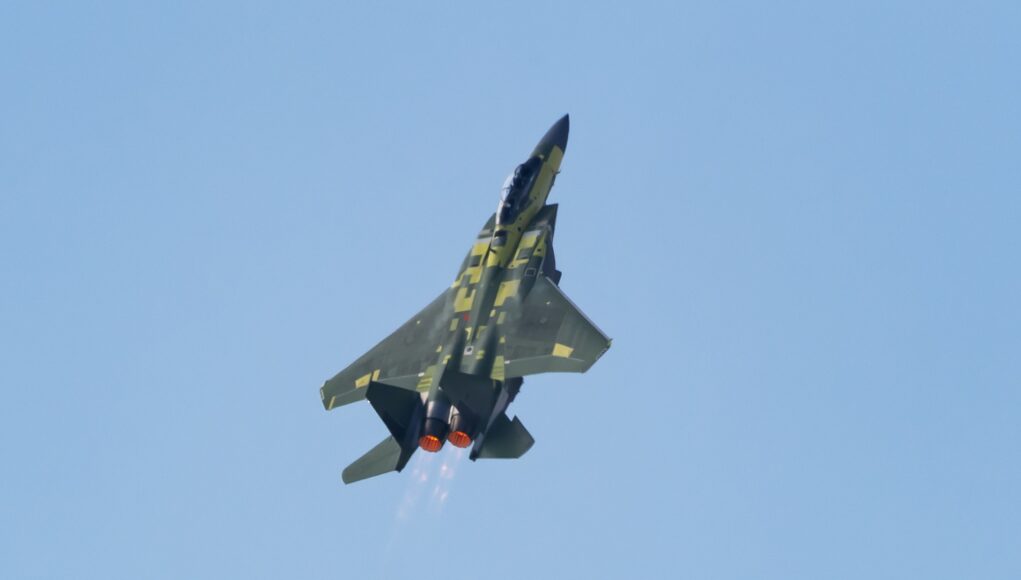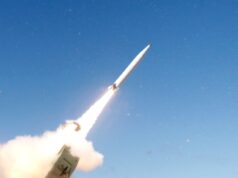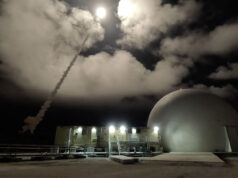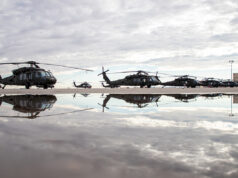The newest U.S. Air Force fighter, the F-15EX, has completed a 90-minute test flight.
Deliveries are to begin this quarter say Boeing.
“Today’s successful flight proves the jet’s safety and readiness to join our nation’s fighter fleet,” said Prat Kumar, Boeing vice president and F-15 program manager.
“Our workforce is excited to build a modern fighter aircraft for the U.S. Air Force. Our customer can feel confident in its decision to invest in this platform that is capable of incorporating the latest advanced battle management systems, sensors and weapons due to the jet’s digital airframe design and open mission systems architecture.”
Boeing say that the fighter’s digital backbone means it can “serve as a testbed for future technology insertion, a key capability for the Air Force”.
Modern variants of the F-15 also include fly-by-wire flight controls, an all-new digital cockpit, modern AESA radar and the ADCP-II, a cutting-edge mission computer.
“The F-15EX, the most advanced version to date, features the Eagle Passive/Active Warning and Survivability System electronic warfare system to improve mission effectiveness and survivability for operators.”
In July, the U.S. Air Force awarded Boeing a contract to build the first lot of eight jets. Future plans could call for as many as 144 aircraft.










Reckon the RAF Tornado version will be a better bet though.
What Tornado version?
Tornado F3 was a dog!
It certainly was not!
Yes it was… it was a bomber with a good air radar. It was outclassed in dogfights, It only had its radar and AMRAAM to give it an edge.
It Was never meant to be a Dog fighter, and although initially when it was introduced it didn’t really offer that much more than the Phantoms it replaced, it was good enough for the Job. Its not really Comparible in Performance to me Typhoon obviously, but the F3 had better Performance than the GR1/4 due to its more efficient Airframe. When it Retired it was also Capable of SEAD which was an unexpected Bonus.
Dog fights it’s not WW2
Introduced into service in Jan 1976, nine months before I was born. It is amazing to think that a version of the same aircraft design will still be in service into the 2050s and beyond. It just goes to show that not everything needs to be gold plated to be effective.
Then also consider the B52 has a lot of life left on it as well.
Think of the C130 then…
Land Rover, probably still has at least one washer that is the same as the original.
You have to consider the number of aircraft the USAF has. 144 standoff missle trucks have a role to play in high and low threat environments.
Naturally, in low threat, they can carry many more munitions than the F35, whereas in high threat, the F22 and F35 will paint targets for the F15 to engage from afar, without ever exposing their own position or using internally stored munitions.
I wouldn’t be at all surprised if one of the reasons the USAF went forward with the F-15EX buy is that it has a classified hypersonic cruise missile program ideally suited for it.
Yet, they still won’t buy Meteor? Instead opting to develop the rival Joint Advanced Tactical Missile AIM260.
Since no one knows what the capabilities of the AIM260 are that’s a moot question.
At the same time there’s now talk about new build F16’s as well…
Question: it is beneficial to Lockheed Martin a new order of F-16? They make a lot of money with the F-35, so doesn’t make sense focus on the Lightning?
The F15 was way ahead of its time and by far the world’s most potent fighter jet when it entered service in the mid 70’s. This update must surely highlight the fact that such upgrades at a fraction of the cost of new hardware such as eg the F35, give way more value for money than their vastly expensive replacements! I marvel at the fact that earlier versions of this machine were in the hands of the US Air National Guard-essentially the equivalent of the RAuxAF!!
As mentioned by John above, in a peer vs peer conflict these will only be used as missile trucks by F22s and F35s. The X version does not use any of the Silent Eagle developments. The main change structurally is the use of the E version’s stronger wing. Yes, you can upgrade the avionics etc, but the fundamental design has not changed. Therefore, it still has a massive radar cross section (RCS) from all aspects, due to its unshielded engine intake and exhausts, lots of 90 degree corners and an unshielded cockpit. Therefore, the Raytheon AN/APG-63(V) radar it will have, will definitely have its work cut out, as the aircraft may be seen before it detects its threat. I am a bit surprised they aren’t going to use the later AN/APG-82 that is being used to upgrade the F15Es? Both are AESA systems, but the -82 radar is a true multi-mode radar that also do electronic attack.
Thanks Davey. here’s a What If- what if a system is developed to identify low signature aircraft such as the F35? Quo Vadis’Stealth” ?
That’s a big if! Some say a passive radar network can counter stealth or long wavelength HF/VHF radars. But neither of the systems are any good at providing a targeting solution. Until quantum radar is made viable, I don’t believe we will see the end of aircraft designed with reduced radar signatures. Even the often mooted photonic radar will struggle to see a very low RCS aircraft like a F35. So there’s still a future for stealth.
Boeing estimates that an F-15EX will cost roughly $80 million; meanwhile, last year’s F-35 contract between Lockheed and the Pentagon sets the cost of a conventional-takeoff-and-landing F-35A at $79.2 million in the upcoming Lot 13
The Legacy F15/16’s are Running out of Airframe Hours Quicker than the F35 can Replace them,also the F35 is Significantly more Expensive to Operate per Flight Hour than the F15.
You have to remember a lot of the costs in things like F35 where not the airframe itself, but the complex software to fly the thing plus advanced radars and sensors. Much of the radar and sensor technology can easily be integrated into F15 at low cost. But an F35 will now cost little more than an F15 off the production line because the R&D was sunk into flying a new airframe.
It’s the biggest risk to tempest because all of that work has to be repeated again while F35 will receive continuous upgrades for the next 50 years without the huge initial cost.
Thanks for your input BB85. I don’t have the technical knowledge of many on this site-just have had a general interest in military aircraft all my life and from a business perspective. I would have though that the setup costs on the assembly line would have been amortized many years ago so that a 45 year run would give a distinct cost advantage over the likes of state of the art jets such as the F35. However I understand what you say in terms of where the real cost lies. What are your thoughts on the possibility of detection systems advancing to the stage where it is possible to detect even a so called stealth aircraft to the same degree as conventional radar? This would be a huge game changer for those aircraft invested so heavily in stealth! Also, in terms of maneuverability and climb rates etc, surely the F15 is streets ahead of the F35 even given for the fact that these capabilities are not as important as in previous times given the long reach and stand off capabilities of the new generation?
The US Air National Guard is something else, one of their units flies B2 Spirits!!
Are these completely new build aircraft from the original assembly line or refurbished examples? If the former then their unit cost must have plumetted or Boeing are making a fat margin(deservedly) on these aircraft.
These are completely new aircraft. The F-15 production line has never been shut down. It was kept open for foreign orders. In fact, Saudi Arabia and Qatar financed most of the improvements incorporated into the F-15EX.
Thanks PK
I think this is where we in the UK consistantly miss the opportunity to use old airframes when use can be found for aircraft which are beyond their intended design. We have many already designed and proved airframes which cost peanuts compared to the price of a new Typhoon or F35. These could be used for the new “loyal wingman” program where removing the pilot, avionics, seat etc. and outfitting the aircraft with a secure command system and modern weapons would enable the MOD to have a cost effective force multiplier and provide jobs for our UK workforce. Hawk, Gnat with some major mods?
The Gnat did really well for India against Pakistani Sabres